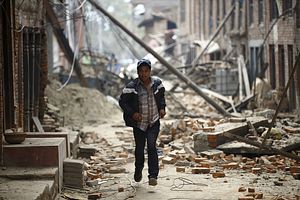Several years ago, I went on an “Earthquake Walk” in downtown Kathmandu, a walk designed to raise awareness about the city’s vulnerability to a major earthquake. As we ducked into a traditional courtyard, winding our way through a low narrow corridor before emerging into an open square surrounded by high traditional homes, we saw a big stick propping one edge of a building up against another. I’ve thought a lot about that stick today—its inadequacy, its fragility—as news of Nepal’s quake poured in.
Nepal has been waiting for the quake of April 25, 2015 for some years, conscious that it was “overdue” for another. The U.S. Geological Survey has called Nepal “one of the most seismically hazardous regions on Earth.” It sits at the intersection of two tectonic plates, the India and Eurasia, colliding together quickly in geological terms—forty to fifty millimeters each year. That pressure eventually gets released as earthquakes.
Nepal’s last significant earthquake—8.1 on the Richter scale—occurred in 1934. That quake resulted in nearly eleven thousand deaths (around seventeen thousand in both India and Nepal), and caused significant devastation to buildings in the Kathmandu Valley. Prior to that, a quake of between 7.5 and 7.9 took place in 1833.
The quake on April 25, measuring 7.8 on the Richter scale, had its epicenter forty-eight miles (seventy-seven kilometers) northwest of Kathmandu. It shook the city; ancient buildings crumbled; and as of late evening Nepal time on April 25, the Nepali government estimated the death toll at nearly fifteen hundred with the expectation it would rise.
A major part of Nepal’s vulnerability to earthquake disaster lies in poor infrastructure governance—like the stick serving as a makeshift buttress between buildings. Since the quake of 1934, Nepal’s population has grown, become more urban, and therefore denser. Urban population growth results in rapid building, and Nepal has seen the mushrooming of brittle, multistory concrete structures with little seismic resistance throughout the Valley. Additional levels perched on top of narrow structures originally designed two to three stories high dot Kathmandu’s urban landscape. Buildings like this are clearly not to code by any definition, and create man-made hazard.
Due to this known seismic vulnerability, the Nepali government has been focused for some years on a disaster risk reduction approach. The United Nations Development Program (UNDP) and supporting governments, including the United States, have worked with Nepal to identify steps it can take. A brief on UNDP’s Comprehensive Disaster Risk Management Programme is available here.
Those steps run the gamut from retrofitting buildings for seismic resistance; strengthening governance practices on matters of zoning and building codes; helping Nepal develop a more robust disaster response management capacity; creating better advance preparations for search and rescue to save more lives; and raising public awareness to the steps individuals can take to prepare themselves better. Nepal developed a National Strategy for Disaster Risk Management in 2008, and has been working to implement it. But progress has been halting due to the country’s problem of on-again-off-again government especially during 2012 and 2013.
Nepal has declared a state of emergency now. UNESCO World Heritage sites in downtown Kathmandu have crumbled, and more news of widespread damage will likely emerge in the coming days. Nepal will need all the help it can get from its neighbors. India is taking the lead on humanitarian assistance and has already sent flights with relief and rescue personnel; Pakistan has offered assistance as well, and Nepal has asked for help from China. Other international partners are mobilizing quickly—the United States has sent $1 million and a team of disaster relief experts. It will be grim work to identify and rescue those trapped, and then rebuild in the days to come.
I am quietly hoping that the courtyard homes with the jerry-rigged stick repaired their walls since that earthquake walk, and that they and their families are safe.
Alyssa Ayres is Senior Fellow for India, Pakistan, and South Asia at the Council on Foreign Relations. She blogs at Asia Unbound. This post appears courtesy of CFR.org and Forbes Asia.
































